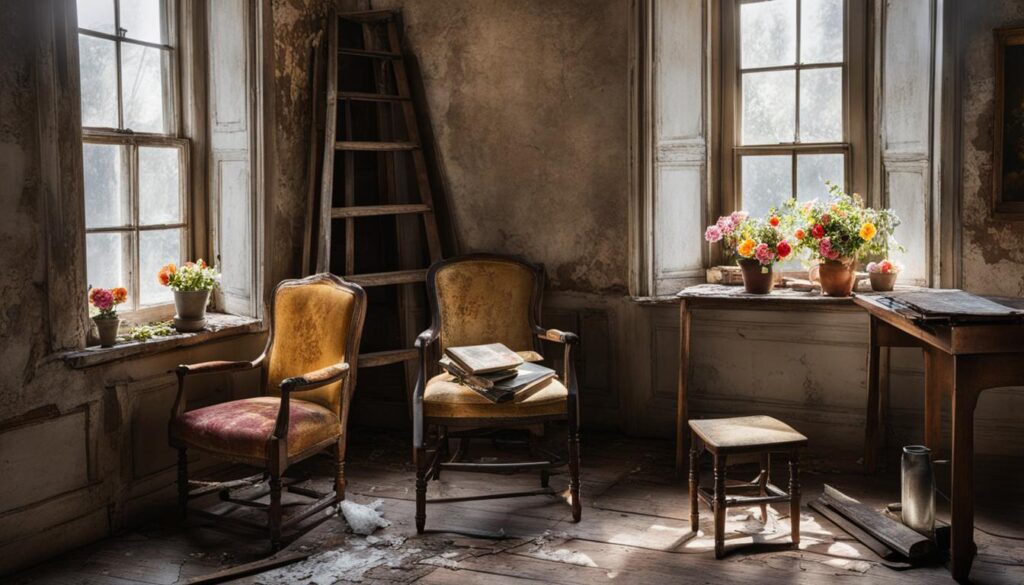There’s something profoundly beautiful about reviving the splendor of an old home. Having spent my childhood in a family home from the 1890s, nestled in a historic neighborhood, I’ve developed a profound appreciation for the stories embedded in older homes. It’s a delicate dance, finding the perfect rhythm between preserving that inherent charm and infusing contemporary convenience. In my experiences with old house renovations, I’ve learned that the true magic lies not in recreating what was, but in emboldening what is—with a respectful nod to its origins. Let’s delve into the world of house renovation ideas and explore how to master the craft of remodeling an old house while treasuring its classic allure.
Key Takeaways
- Approaching old house renovations with a mindset to preserve, not just update, amplifies their historic value.
- Intimate knowledge of your home’s era is crucial for authentic house renovation ideas that honor its past.
- Successful remodeling of an old house is finding harmony between the old-world charm and modern amenities.
- Every renovation decision should be made with the intent to enhance, not overshadow, the home’s original character.
- The beauty of renovating an old house lies in revealing and celebrating its stories, layer by layer.
Embracing the Historical Essence of Your Home
Renovating historic homes breathes new life into their structures, while mindful efforts to restore an old house can forge an indelible connection between past and present. These structures are not just mere buildings; they’re embodiments of history, each with a story to tell. As I set out on the journey of historic home restoration, it becomes more than construction—it’s an act of preservation, an homage to the artistry and craftsmanship that have stood the test of time.
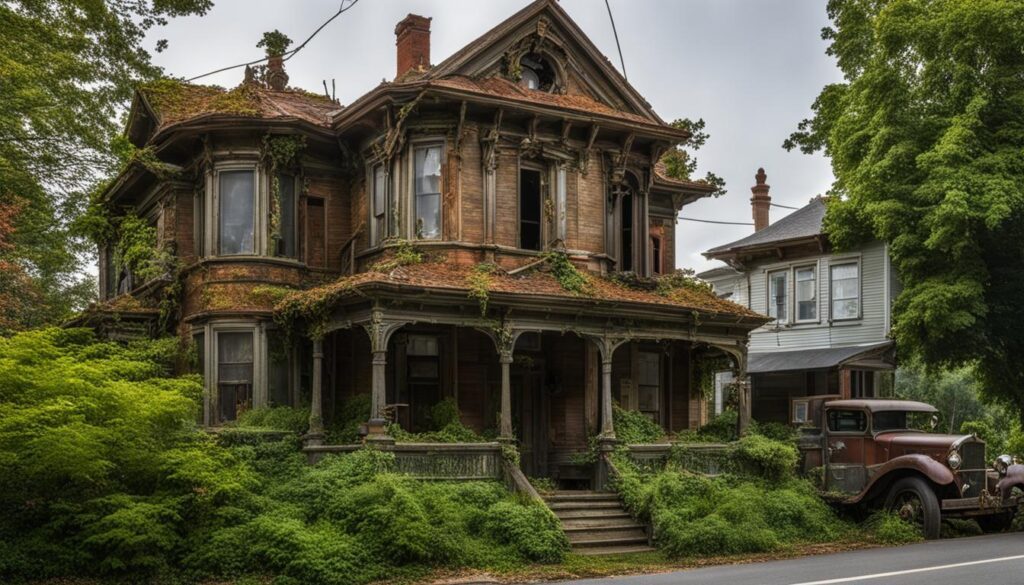

Uncovering the Tales Behind Vintage Walls
Each creaky floorboard and every layer of peeling paint in an old home whispers tales of yesteryear—stories that demand to be heard and respected. The allure of restoring old homes for me lies in the ability to uncover these tales, gently peeling back the layers of time to reveal the home’s true character. Embracing the tales of these vintage walls, I’m often reminded of long-forgotten architectural techniques and lifestyles that these historic gems were born from.
Maintaining Original Features Whenever Possible
In neighborhoods like Hintonburg and Wellington Village, where historic charm is the lifeblood of the community, maintaining the original features of a home becomes a mission. Opting to preserve elements like original hardwood floors not only serves to uphold the authentic aesthetic but also proves to be a wise, cost-effective approach. From ornate crown moldings to classic hardware, each component I choose to save weaves itself into the tapestry of the home, ensuring that the spirit of the era remains untouched.
- Preserving original floors enhances authenticity
- Cost-effective choices pay tribute to the home’s history
- Respect for architectural integrity in choices of preservation
The delicate task of preserving these relics of the past, while breathing contemporary life into them, is what makes the process of renovating historic homes truly remarkable. As I proceed, I do so with reverence, ensuring each stroke of my work contributes to the continuum of the home’s legacy.
Strategic Updates for Old House Renovations
When I decided to renovate an older home, I knew it would be a blend of maintaining its storied character and strategically incorporating modern updates. The challenge was in honoring the home’s original integrity while adapting it to today’s lifestyle. Transforming an old house required a thoughtful approach, respecting not only the structural quirks but also the historical significance of its design features.
One of the first steps in updating an old house is addressing foundational concerns. As these homes often present themselves with uneven floors and walls that have settled over the decades, it’s crucial to work with skilled craftsmen. Carpenters and structural engineers become your allies, helping to ensure that any enhancements are safely implemented without compromising the home’s stability.
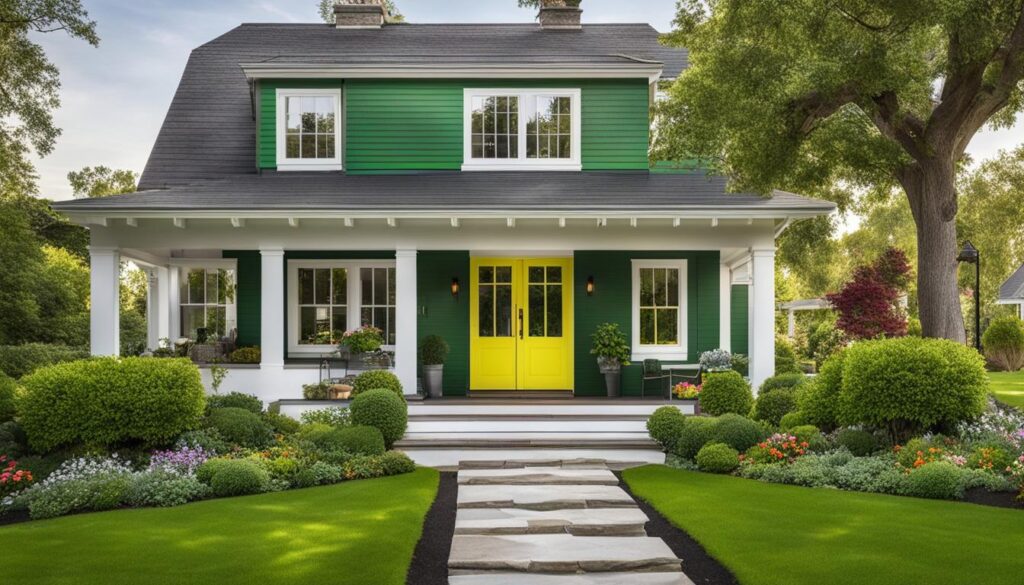

My journey emphasized preserving key architectural details while allowing for modern conveniences. For me, it was imperative to:
- Utilize the unique nooks and crannies of the home for additional storage or decorative spaces.
- Retain the smaller scale of original moldings, trims, and built-in furniture to keep the authentic feel.
- Maintain the original sightlines and flow of the house to promote a seamless blend of old and new.
These considerations became guiding principles in ensuring the renovation felt cohesive and respectful to the building’s past. Whether it was a simple update to the lighting fixtures or a more complex structural change, the aim was always to enhance the home’s charm while equipping it for the demands of modern living. By infusing creativity into every decision, I found that it’s truly possible to honor the past while crafting a space for the future.
Incorporating Modern Amenities Without Losing Character
As I delve into the world of renovating an old house, I find there’s a distinctive charm in seamlessly integrating modern conveniences within a vintage house makeover. It’s about striking the perfect balance that honors history while embracing the comforts of today. Let me share a few insights on how to blend these worlds together, preserving the soulful essence of a heritage home.
Blending Contemporary Conveniences with Heritage Accents
When I approach modernizing an old house, it’s not just about adding new features; it’s about creating harmony between the old and new. For instance, in the kitchen—an area where functionality is key—I like to marry quintessential period details like a pressed tin ceiling with state-of-the-art appliances. It’s about offering the modern efficiency we all crave without upstaging the home’s intrinsic character.
- Choose appliances that reflect the vintage aesthetic, perhaps with a retro design, yet offer the latest technology.
- Install statement lighting fixtures that draw from the past but are LED-efficient.
- Opt for cabinetry that has a timeless appeal, with modern organizers tucked inside.
The Art of Concealing Modern Features
The trick to a successful vintage house makeover often lies in the subtlety of the modern touches. Take for example the restroom; I prefer to select fixtures that reflect the time period of the home but hide the modern functionalities they’re equipped with.
- Discreetly integrate USB ports and smart home controls in areas that don’t detract from the home’s original features.
- Use smaller tiles in shower stalls to keep in line with the scale of past eras, while incorporating modern water-saving shower systems.
- Employ clever storage solutions that reduce clutter, maintaining the clean lines and open feel typical of historic homes.
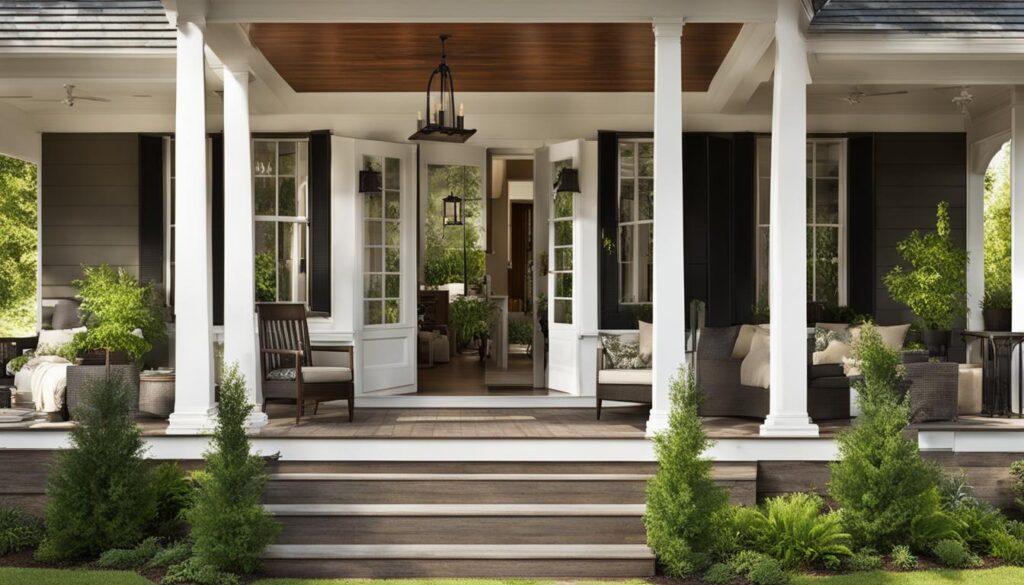

In essence, my philosophy for modernizing an old home revolves around respect—for the architecture, for history, and for the stories these walls tell. It’s about writing the next chapter in a way that feels cohesive and natural, a confluence of yesterday’s charm with the conveniences of today, crafting spaces that feel both timeless and timely.
Revitalizing Traditional Architectural Elements
As I dive deeper into the world of renovating outdated properties, I’ve learned that the true magic lies in breathing new life into the traditional architectural elements that make a house a home. For me, this often involves finding ways to seamlessly integrate cherished historical details with functional modern updates. And let me tell you, there’s nothing quite like the satisfaction of seeing an old, forgotten space restored to its former—or, dare I say, new—glory.
Take the front door, for example. It’s more than just an entryway—it sets the tone for the entire home. During one of my recent traditional house renovations, I had the opportunity to restore an old house with a stunning Victorian door. The goal was not just to refurbish it but to highlight its storied past. With careful repairs and a fresh coat of paint in a historically accurate color, I brought back its original charm, inviting visitors to step back in time as they enter the modern comforts of the home.
- Examining the quality and condition of original woodwork and deciding how best to restore it.
- Rehabilitating vintage light fixtures to their former splendor as they light up contemporary living spaces.
- Applying period-appropriate paint schemes that pay homage to the past while fitting seamlessly within today’s design expectations.
- Preserving the texture and charm of original plasterwork, artfully repairing any damage.
Under my careful direction, what was once outdated is now artfully renewed, maintaining the soul and story of the property. This is more than a renovation; it’s a revival of heritage—a loving tribute to the craftsmanship and vision of yesteryears, and an invitation to future generations to continue celebrating the undying spirit of a timeless household.
Old House Renovations: Balancing Timelessness and Trendiness
Knowing the heart of renovating an outdated house lies in striking that perfect chord between the evergreen charm of the past and the allure of modern trendiness. I’ve learned through my experiences that this fusion creates a harmonious symphony which resonates within the walls of an old house remodel. Let me share how I blend the two to honor the heritage while injecting a fresh pulse into the renovation of an old house.
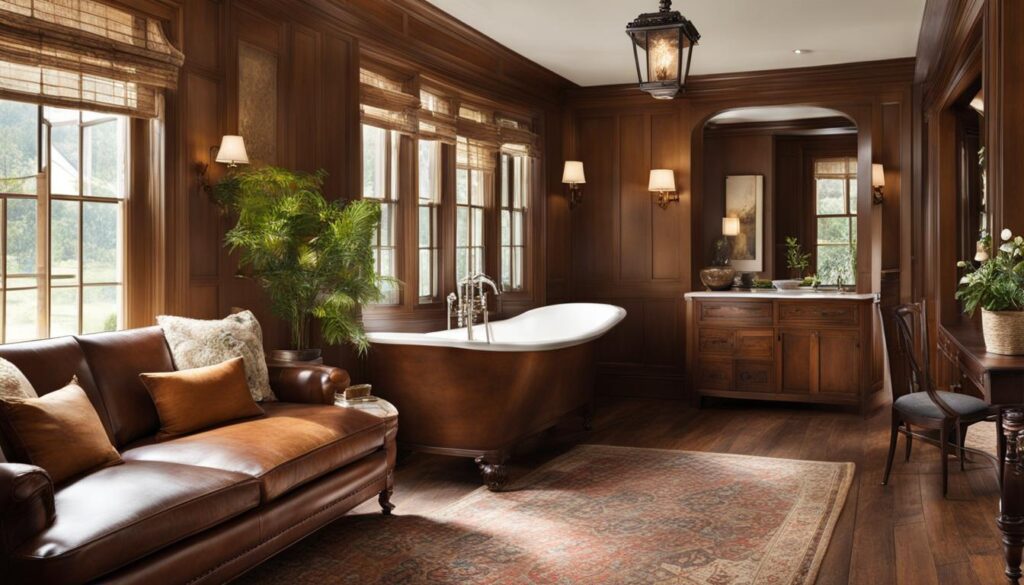

Integrating Trendy Accents in a Classic Setting
Adding contemporary touches to an old house remodel doesn’t have to overshadow its original character. Instead, I aim to complement the vintage charm of my home with selective, stylish upgrades. For instance, striking the right balance can be as simple as introducing sleek, minimalist shelves amidst the elaborate, existing millwork or choosing color palettes that both reflect the home’s era and speak to today’s design trends.
Choosing Renovations That Complement the Home’s Era
During a renovation of an old house, I believe in honoring the home’s architectural lineage. This philosophy guides me in picking out renovations, like wainscoting or tin ceilings, that are reminiscent of the house’s era. These elements not only pay homage to the past but also ensure that each new addition feels like a natural extension of the original design narrative, rather than an out-of-place modification.
- Bold yet timeless patterns for wallpaper or tiles that capture the essence of the home’s history
- Restoration of vintage fixtures, where the century-old craftsmanship remains the protagonist
- Modern tech upgrades smartly hidden within classic features, preserving aesthetic integrity
I instinctively gravitate towards restoration choices that tell a story, bridging generations with a touch of modernity, ensuring the spirit of the old house is not just preserved but also celebrated.
Restoration Techniques for Vintage Charm
I’ve always believed that restoring older houses is about more than just repairs and a fresh coat of paint; it’s an art form that celebrates and preserves the legacy of our architectural heritage. For those of us passionate about renovating a neglected house, the techniques we use are as important as the materials themselves. It’s a journey of uncovering potential and nurturing it to bring a dormant beauty back to life.
Repurposing and Reclaiming Antique Materials
One method I’ve adopted in my quest to rejuvenate historic houses involves the careful repurposing of antique materials. There’s something remarkably gratifying about taking century-old pine flooring that others might discard, and reviving its alluring patina through resurfacing and staining. These materials carry the home’s past; reusing them connects us to its storied history and reduces our environmental footprint.
- Finding creative uses for vintage moldings as frames or accents
- Repurposing weathered bricks from non-structural walls for garden pathways
- Turning old, ornate door knobs into stylish curtain tie-backs
Tricks for Restoring Original Woodwork and Hardware
Restoring classic woodwork and hardware can transform a room from dated to timeless. Here’s where a delicate touch and an eye for detail really come into play. For example, I never underestimate the power of a well-concocted mixture of linseed oil and turpentine to nurse old wood back to vibrancy. It can reveal the innate character of the wood grain that modern stains simply can’t replicate.
- Strip paint meticulously with heat guns and gentle scraping
- Oil hinges and locks to preserve their function and form
- Polish brass and copper fixtures with natural cleaners like vinegar and baking soda
Every project brings new challenges, but also the thrilling chance to write a new chapter in a home’s history. The result isn’t just a renovated space; it’s a lovingly rejuvenated environment that respects its roots while standing ready to create fresh memories.
Custom Solutions for Updating An Old House
When I embark on old home renovations, I often find myself pioneering unique solutions that respect the intimate narratives of these time-honored structures. Each structure, especially when renovating an old farmhouse, has distinct needs that demand a personalized approach.
- Creating custom cabinetry to fit into irregular, non-standard spaces while mimicking historical design.
- Selecting paint colors and finishes that enhance the original woodwork and avoid anachronistic clashes.
- Working with local craftsmen to replicate ornate features that cannot be found off-the-shelf.
- Incorporating period-appropriate hardware that adds a touch of authenticity to every room.
One of the old home renovation ideas I am particularly proud of included the precise matching of new moldings to century-old trims within a Victorian mansion. The seamless integration allowed modern enhancements to blend indistinguishably with the classic features, a testament to detail-oriented craftmanship.
Moreover, preserving the essence of space while adapting it to contemporary living standards is my philosophy. This not only involves aesthetic decisions but extends to incorporating modern efficiencies in a way that’s sympathetic to the building’s heritage.
The delight in making these storied homes sing again with life, rejoicing in the new chapter of their existence, resonates deeply with my commitment to conservation and rejuvenation. It’s a harmonious convergence of my expertise in old home renovations with the homeowner’s vision, culminating in spaces that resonate with both history and functionality.
Conclusion
As I reflect on the intricate tapestry of renovating classic houses, the chapters of my journey unfold, each one an intimate collage of past and present. The transformation of an old house is more than mere construction; it is the rekindling of history, a labor of love that pays homage to the essence of bygone eras. Old house renovations have shown me that the beauty of these endeavors springs from the delicate balance between upholding historical integrity and integrating modern-day comforts.
Reflecting on the Journey of Renovating for Classic Charm
Each stroke of the hammer, every brush of paint has been a step in preserving the narrative that these venerable walls whisper to those who listen. The process of transforming an old house has been as much about discovery as it is about creation; it’s about peeling back layers of the past and infusing them with a new lease on life that respects their original story.
Next Steps in Your Old House Renovation Adventure
As the next steps in your personal renovation adventure beckon, remember that the journey is as significant as the destination. The rewards of renewing classic dwellings are boundless, extending their legacies and ensuring they stand proudly as testaments to history’s architectural splendor, all while cocooning the comforts of modern living. Forge ahead with passion, knowing that with each decision, you are contributing to the timeless dance of preserving history through old house renovations.
FAQ
What are some essential tips for renovating an old house?
When renovating an old house, it’s essential to respect the home’s history while integrating your modern needs. Focus on maintaining the original features that give the house its charm, such as woodwork and architectural details. Also, plan your renovation to ensure any updates you make don’t detract from the character of the house.
How do I embrace the historical essence of my home during a renovation?
Start by researching the history of your home and the period it was built in. Preserve and restore original features where possible, such as windows, floors, and moldings. If you need to replace anything, look for historically appropriate materials and designs. Work with experts in historic home restoration to maintain authenticity.
What are strategic updates I can make in an old house renovation?
Prioritize updates that improve the function of the house without compromising its style. Systems like plumbing, electrical, and heating/cooling should be modernized for efficiency and safety. Look for ways to add modern conveniences tastefully, such as upgraded kitchens and baths that reflect the home’s era.
How can I incorporate modern amenities without losing the character of my old home?
Choose contemporary features that blend seamlessly with the house’s period style. Install modern appliances that have a vintage look, use paint colors that complement the era, and conceal technology where possible. It’s about finding the right balance between old and new.
What traditional architectural elements should be revitalized in an old house?
Traditional architectural elements like transoms, cornices, baseboards, and crown molding should be repaired or replicated if damaged. Look for ways to bring out the original craftsmanship, like stripping and refinishing old woodwork or cleaning and repointing brickwork.
How can I balance timelessness with trendiness in my old house renovation?
Focus on timeless updates that harmonize with the home’s architecture. Use trendy elements sparingly and in a way that they can be easily changed in the future. Bold accents in decor are easily swappable, allowing you to mix trends without permanent alterations to the structure.
What restoration techniques should I use to maintain vintage charm?
Use gentle cleaning and refinishing techniques to preserve original materials. When salvaging, look for period-appropriate pieces from salvage yards or antiques dealers. Be patient with the process; proper restoration takes time but is worth it to maintain the home’s vintage charm.
When updating an old house, what custom solutions might be necessary?
In many cases, you may need to have custom pieces made to match existing fixtures or fittings, especially when dealing with trim, hardware, or windows. Sometimes, adapting spaces to fit modern uses while preserving the historic feel requires innovative design solutions. Working with skilled artisans and craftspeople who understand old homes can be invaluable.
How can I make my old farmhouse renovation feel authentic?
Keep the farmhouse’s rustic charm by retaining or adding features like exposed beams, original flooring, and even vintage faucets or light fixtures. Use materials that would have been available during the farmhouse’s original construction period for any new additions or replacements.
What should I keep in mind when restoring old homes in historic neighborhoods?
Always check with your local historic preservation society or regulatory board before starting your renovation for any restrictions or guidelines. Strive to maintain the architectural integrity of the neighborhood by preserving the exterior look and key historic features of your home.

